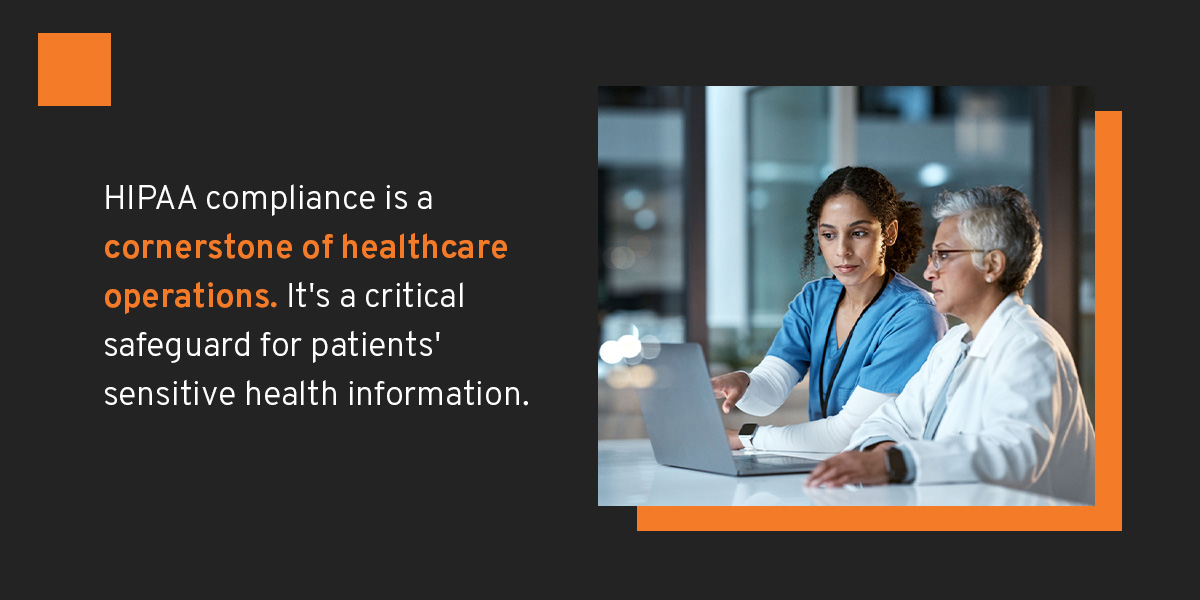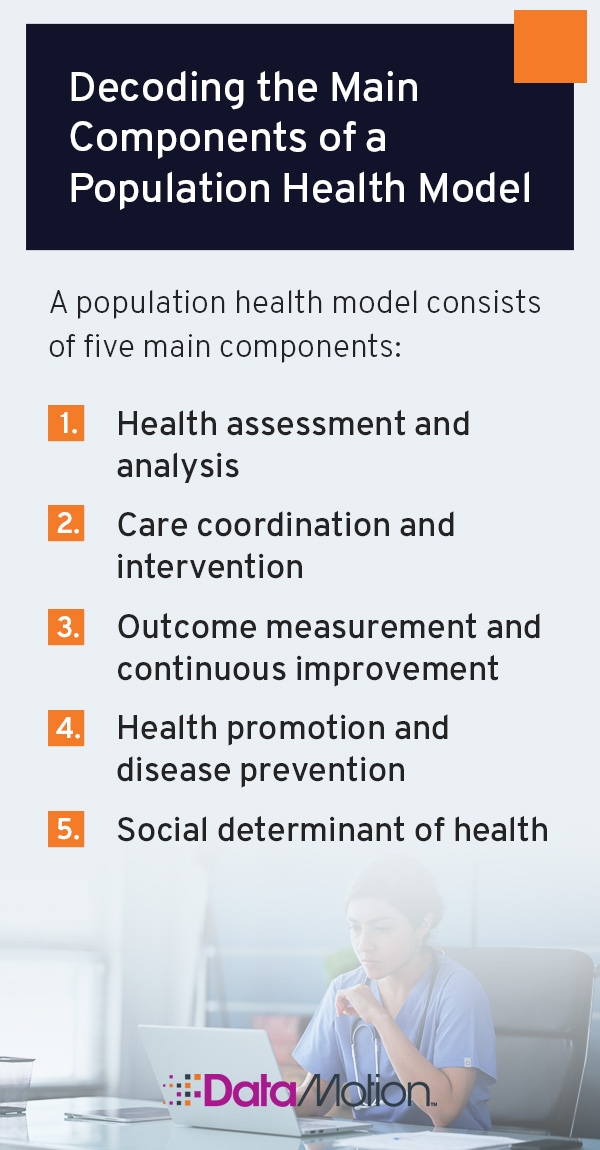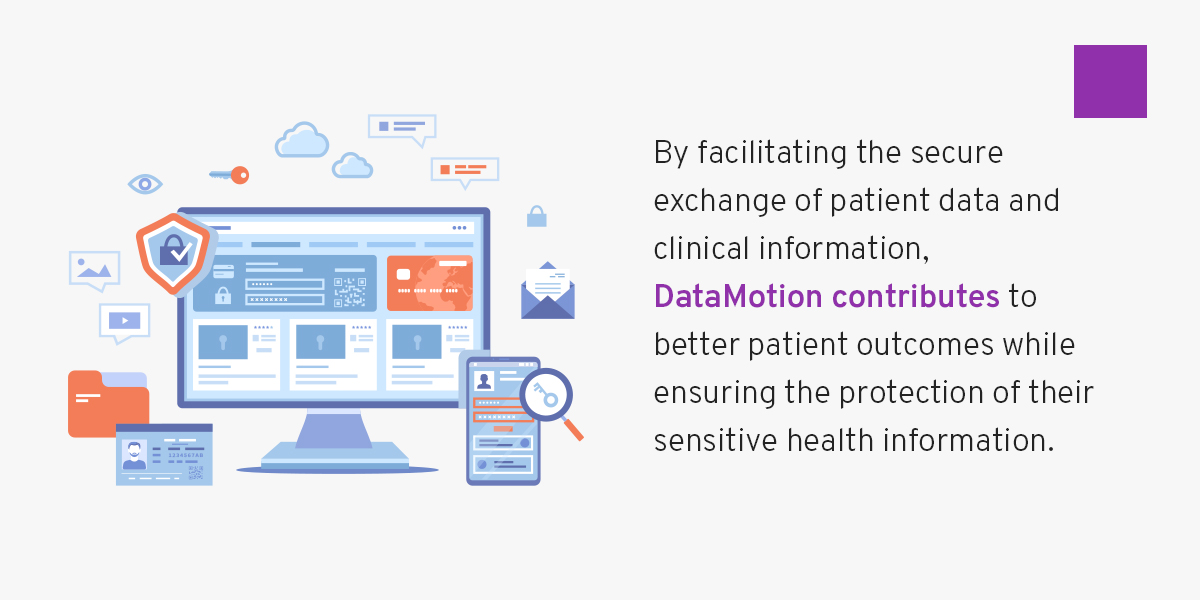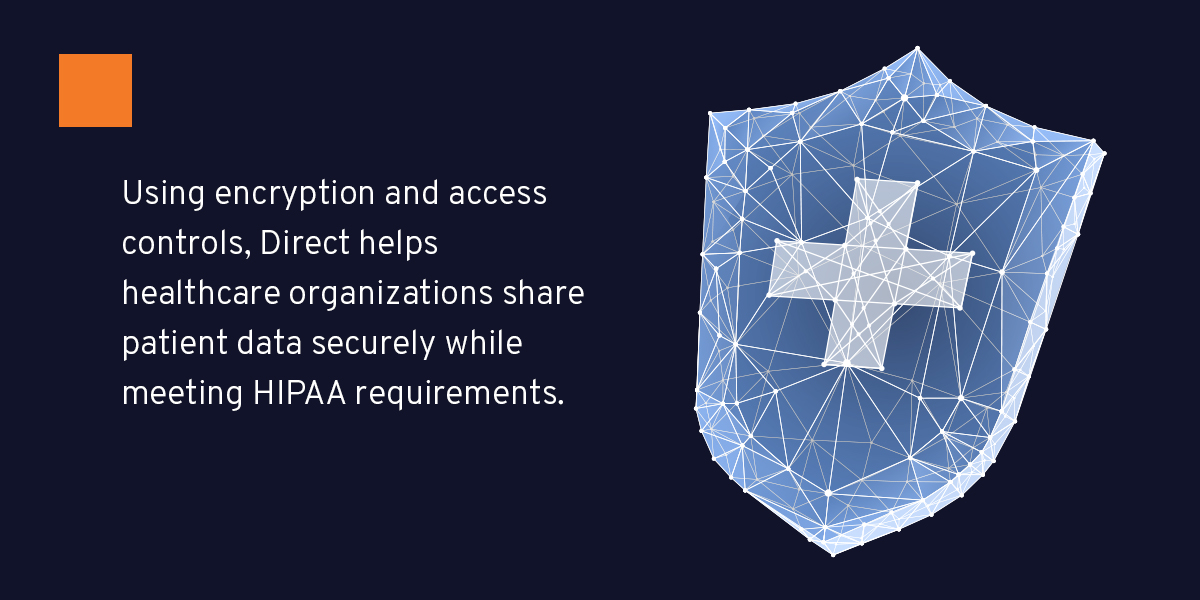Population health management (PHM) is the improvement of the health outcomes of a group of patients with similar characteristics. One example of a population in this context are patients suffering from the same chronic condition. The care of patients in this group may be managed similarly, often involving the same treatments, tests, procedures and other forms of care.
The treatment of chronic conditions typically involves multiple parties, from a primary care physician to multiple specialists and of course the patient. This, in turn, requires frequent communications between the parties.
Electronic health records (EHR) systems were intended to facilitate these communications but have some shortcomings. And maintaining Health Insurance Portability and Accountability Act (HIPAA) compliance is a key challenge. This article looks at how organizations can use Direct Secure Messaging to overcome the technical and regulatory challenges of a Population Health Management communication scenario.

The Importance of HIPAA Compliance in Healthcare
HIPAA compliance is a cornerstone of healthcare operations. It’s a critical safeguard for patients’ sensitive health information. Compliance ensures that healthcare organizations maintain the confidentiality and integrity of patient data, promoting trust and accountability in the industry. In the age of population health management — where data sharing and analysis are essential for improving healthcare delivery — HIPAA compliance becomes even more vital.
Understanding the HIPAA Compliance Rule
The HIPAA compliance rule governs how healthcare organizations handle protected health information (PHI), including how PHI is collected, stored, transmitted and used. It establishes guidelines for healthcare entities to protect patient privacy and data security.
HIPAA applies to various healthcare entities, including hospitals, clinics, insurance providers and business associates. It covers healthcare professionals and organizations handling PHI, helping to secure your data. Essentially, it means doctors can share patient information with other doctors to help treat you, but they cannot share it with your neighbor.
The compliance rule mandates strict safeguards for PHI, including administrative, physical and technical measures. These safeguards are designed to prevent unauthorized access, data breaches and other security threats.
Addressing the Three Key Elements of HIPAA Compliance
To achieve HIPAA compliance, healthcare organizations must focus on three key elements:
- Administrative: Administrative safeguards involve establishing policies and procedures for protecting PHI. They include workforce training, risk assessments and designating a security officer responsible for compliance. Effective administrative safeguards ensure responsible data handling and HIPAA compliance.
- Physical: These measures relate to protecting the physical infrastructure where PHI is stored. This includes access controls, facility security plans and device encryption. With the expansion of EHR and data centers, physical safeguards are essential to prevent unauthorized PHI access.
- Technical: Technical safeguards focus on the technological aspects of data security. They cover measures like access controls, encryption and audit trails. Robust technical safeguards are essential for protecting PHI during transmission and storage.
Population Health Management and HIPAA Compliance
Population health management has emerged as a pivotal approach to enhancing patient outcomes and healthcare quality. While the benefits of PHM are evident, it must operate within a framework of strict data privacy and security standards outlined by HIPAA.

Decoding the Main Components of a Population Health Model
Population health models allow healthcare entities to review healthcare data for a population. With this data, they can look for healthcare needs and develop strategies for addressing them. A population health model consists of five main components:
- Health assessment and analysis: This component involves collecting and analyzing health data from various sources, including EHRs, claims data and patient-reported information. These insights drive healthcare strategies and interventions. In the context of HIPAA compliance, it’s critical to ensure the collection and analysis of patient data follows privacy and security standards.
- Care coordination and intervention: Once health status is assessed, the next step is coordinating care and implementing interventions. This involves collaborating among healthcare providers, care teams and community organizations. HIPAA compliance is critical here, as the sharing of patient information among stakeholders must be managed carefully to protect patient privacy.
- Outcome measurement and continuous improvement: The ultimate goal of population health management is to improve health outcomes. Regularly measuring and assessing the impact of interventions is key. This component relies on data analytics and performance measurement. Health information management professionals ensure the data is accurate, complete and accessible while following HIPAA regulations.
- Health promotion and disease prevention: Healthcare organizations must ensure that any communication or educational materials promoting health are HIPAA-compliant and do not disclose PHI without the patient’s consent.
- Social determinant of health: Organizations collecting data on socioeconomic factors for addressing social determinants of health must protect sensitive information in compliance with HIPAA.
Achieving Successful Population Health Management
With a population health model, healthcare organizations can work to achieve better results for their patients. While population health models are essential, successful PHM hinges on the following:
- Data integration and analytics: Health management needs a comprehensive and integrated data infrastructure. This infrastructure should enable healthcare organizations to aggregate data from various sources and perform advanced analytics to identify trends and opportunities for improvement.
- Patient communication: Engaging patients is central to success. Effective patient communication, including the exchange of health information, enables informed decision-making and patient empowerment. Under HIPAA, healthcare providers must ensure secure and compliant communication channels to protect patient privacy.
- Community partnerships: Collaborating with community organizations, public health agencies and social services is crucial to addressing the social determinants of health. HIPAA compliance extends to these partnerships, necessitating secure data-sharing agreements and risk assessments.
Leveraging Technology for HIPAA Compliance
Technology is pivotal in ensuring patient data privacy and security in today’s digital age. The use of technology and HIPAA compliance can be tricky without the right software. Effective, secure communication among healthcare professionals is essential for timely and accurate patient care. However, this communication must occur within HIPAA regulations to protect sensitive patient information. Secure digital exchange platforms like DataMotion Direct offer a solution by providing a HIPPA-compliant messaging platform.
Role of Secure Digital Exchange Platforms in Achieving HIPAA Compliance
The ideal solution is Direct Secure Messaging (“Direct”) from DataMotion. Direct is a secure email-like communications channel that enables providers to communicate with each other – as well as with patients and other caregivers – in a secure, HIPAA-compliant way. All messages are encrypted and require authentication to send and receive.
Importantly, Direct is an enhancement to EHRs, not a replacement. Providers can access Direct from within most popular EHRs.
On the provider side, Direct helps improve patient outcomes in a PHM environment by facilitating the exchange of patient medical records in a standardized manner. This includes formatted and unformatted data, as well as large files such as radiologic studies and diagnostic images. Direct enables better coordination of care. It also reduces errors and delays over conventional means of information exchange; for instance, delays when records are sent by courier, and mistakes due to the illegibility of handwritten notes.
On the patient side, Direct gets patients engaged in the management of their condition, which boosts outcomes. Patients can, for example, provide timely feedback on how well treatments are working, allowing providers to make adjustments accordingly without a delay for the patient to make an appointment with the provider. Patients can report new symptoms, complications or other issues to the provider immediately, thereby potentially avoiding life-threatening situations. And providers can ensure that patients refilled prescriptions when scheduled, or remind patients of upcoming office visits or tests to take.
Managing healthcare is increasingly a team effort. Frequent, accurate communication between the team members – including the patient – is paramount to achieving good outcomes. Direct offers an effective enhancement to EHRs that can help care providers deliver better patient outcomes while complying fully with HIPAA rules for privacy and security.

Redefining Communication in Healthcare: The Intersection of HIPAA and Digital Collaboration
Healthcare communication’s transformation through modern tech is revolutionizing how healthcare is delivered. This digital transformation enhances efficiency and aids in HIPAA compliance. DataMotion is at the forefront of this change, empowering health care organizations to embrace secure and compliant digital collaboration.
The importance of communication in public health is undeniable. By facilitating the secure exchange of patient data and clinical information, DataMotion contributes to better patient outcomes while ensuring the protection of their sensitive health information. As healthcare continues to evolve, the intersection of HIPAA and digital collaboration becomes increasingly important. Forward-thinking solutions like DataMotion Direct pave the way for a more connected and secure healthcare ecosystem.
Facing the Challenges of HIPAA Compliance in Large-Scale Healthcare Solutions
Large-scale solutions are pivotal for improving patient care and health outcomes. However, these innovations come with a unique set of challenges, particularly in the context of maintaining HIPAA compliance. Understanding the technical and regulatory challenges faced in PHM communication and current solutions to these challenges is instrumental in overcoming these obstacles.
The Challenge of Managing Chronic Conditions
Chronic conditions are complex to manage. They typically involve multiple syndromes, symptoms, tests and treatments. They require multiple specialists to manage effectively, as well as a high degree of patient diligence.
Diabetes is a good example. It cannot be cured, only managed for the remainder of the patient’s life. As with most complex chronic conditions, managing diabetes involves regular visits with specialists to ensure that things don’t get worse. Managing a patient’s glucose level is always the short-term concern, but left unmanaged, diabetes can result in catastrophic outcomes such as the loss of a patient’s feet or eyes, or kidney or heart damage.
In addition to the patient’s primary care physician, medical professionals involved in the management of diabetes could include nurse educators, endocrinologists, ophthalmologists, cardiologists, dietitians, podiatrists, exercise physiologists, dentists and others. The coordination of care between so many providers — and with the patient — is essential.
Addressing Technical and Regulatory Challenges in Population Health Management Communication
Part of the promise of EHR systems was that they would facilitate the level of information exchange between healthcare providers that is necessary for coordinating the care of patients. To do that, the HL7 data standard emerged to ensure that the hundreds of EHR products in the market could “talk to” each other. Unfortunately, different EHR vendors interpret the HL7 standard differently, resulting in incompatible data formats. This, in turn, causes missing or inaccurate patient records.
In addition, some EHR vendors employ a proprietary data format that effectively blocks information exchange with EHRs from other vendors. And, some vendors charge providers to enable their systems to interoperate with others.
These constraints make it harder to manage patient care across providers, rendering the ultimate goal of PHM – better patient outcomes – harder to reach. The alternative for information exchange – provider-to-provider email, postal mail or faxes, can result in HIPAA violations (and are slow and unreliable).
Another challenge is that EHRs were designed to facilitate provider-to-provider care. But for PHM, the patient plays a pivotal role in achieving good outcomes. So, too, can family members or other caregivers, such as home health agencies, that might not have access to an EHR.
HIPAA compliance in the context of PHM introduces specific challenges that healthcare organizations must address to effectively manage patient data. Here are key challenges related to HIPAA compliance in PHM:
- Data aggregation and integrations: Clear communication and effective consent management are crucial for obtaining patient consent for data sharing and engagement in population health programs while following HIPAA guidelines.
- Consent and patient engagement: Obtaining patient consent for data sharing and engagement in population health programs, while complying with HIPAA, requires clear communication and consent management strategies.
- De-identification and anonymization: It is crucial to de-identify or anonymize patient information before aggregating and analyzing data for population health to protect privacy.
- Data sharing for research: Collaborative PHM research often requires complying with HIPAA regulations for data sharing and patient consent, adding complexity.
Electronic communication is by far the easiest, most efficient, most reliable and most accountable means of communication between providers and patients. But standard email isn’t a viable option under HIPAA because the identity of the recipient — the reader of the email — cannot be validated. And, regular email is no more secure than sending a postcard with sensitive patient information written on it for all to see, which again presents HIPAA compliance issues. Moreover, regular email lacks documentation and audit trails that all parties involved in the patient’s care can access.

How DataMotion Can Help with These Challenges
Direct offers a secure messaging solution for these challenges. It provides a safe and compliant platform for healthcare professionals to exchange sensitive patient information, ensuring data is protected throughout communication. Using encryption and access controls, Direct helps healthcare organizations share patient data securely while meeting HIPAA requirements. With Direct care coordination, patients can receive better care without information falling through the gaps in healthcare organizations.
HIPAA Compliance and the Nationwide Exchange of Clinical Endpoints
The value of Direct Secure Messaging in large-scale healthcare solutions cannot be overstated. Efficient and secure communication among healthcare providers and organizations is the backbone of effective PHM. DataMotion Direct excels by offering a nationwide exchange network with access to over 2.5 million clinical endpoints.
This extensive network facilitates the secure exchange of clinical information across geographic regions and diverse healthcare entities. Whether it’s sharing patient records, test results or treatment plans, DataMotion Direct ensures sensitive data remains confidential and HIPAA compliant throughout its journey.

Choose DataMotion to Secure Your Healthcare Communication
Large-scale healthcare solutions are transforming how we deliver and manage healthcare. However, with these innovations come significant challenges related to HIPAA compliance and secure communication. DataMotion Direct is a reliable solution, enabling your organization to navigate these challenges effectively.
DataMotion is an accredited Health Information Service Provider (HISP), provisioning Direct services that are fully interoperable with other HISPs. Secure data delivery has been the core of DataMotion’s business since 1999, ensuring your ability to meet HIPAA compliance and Meaningful Use requirements.
By providing secure messaging capabilities and a nationwide network of clinical endpoints, we empower healthcare providers to deliver better patient care while safeguarding the privacy of patient data. If you’re interested in partnering with DataMotion or you want to learn more about our services, contact us online today!




